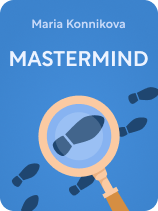

This article is an excerpt from the Shortform book guide to "Mastermind" by Maria Konnikova. Shortform has the world's best summaries and analyses of books you should be reading.
Like this article? Sign up for a free trial here.
How does Sherlock Holmes always solve the case? What can we learn from his legendary deduction skills?
In Mastermind, Maria Konnikova explores the art of Sherlock Holmes’s deduction process. She reveals how his methods can improve our everyday decision-making and problem-solving abilities. Konnikova offers practical strategies to enhance logical thinking and avoid common mental pitfalls.
Read on to enter the world of Holmes and unleash your inner detective.
Sherlock Holmes’s Deduction Skills
For Sherlock Holmes, deduction is an indispensable part of the mystery-solving process. Holmes critically evaluates each scenario against the evidence to deduce the most logical explanation. Konnikova argues that Holmes’s consistent success in unraveling mysteries stems from his ability to engage in disciplined reasoning that is both sequential and exhaustive. This meticulous approach ensures that his final deduction is not just one of many plausible theories, but the only explanation that accounts for all of the evidence.
Konnikova emphasizes that disciplined reasoning is just as critical for everyday decision-making and problem-solving because it safeguards against errors that can lead to poor judgment. We’ll explain how autopilot mode inhibits logical thinking and explore strategies to reach rational conclusions.
Autopilot Mode Favors Intuition Over Logic
Counter to Holmes’s logical approach, when you operate in autopilot mode, you’re more likely to favor intuition over analytical thinking because following your gut demands less cognitive effort than the rigorous process of logical reasoning.
Konnikova explains that, in autopilot mode, your brain seeks to quickly make sense of new information by drawing parallels with past experiences or existing knowledge. The ease of making these connections can create a compelling sense of rightness. This feeling urges you to disregard evidence that doesn’t conform to these preexisting frameworks. As a result, you form conclusions that feel comfortable and reassuring due to their familiarity, rather than conclusions that are factually sound.
For example, when house hunting, you gravitate toward a property similar to your childhood home despite it being smaller and pricier than other options. The logical approach would be to consider more cost-effective properties, but you quickly conclude that it’s the best property for you because it feels familiar and right.
(Shortform note: One reason intuition can lead to inaccurate conclusions is its tendency to perceive patterns and connections between events, even when there are none. One example of this is gambler’s fallacy, the belief that incidental patterns that happened in the past will hold true in the future. For example, when playing roulette, gambler’s fallacy might cause you to believe that the ball is more likely to land on red if it’s landed on black multiple times in a row.)
How to Consciously Formulate Logical Conclusions
According to Konnikova, you can formulate more logical conclusions and overcome the tendency to rely on intuition by adopting a three-part strategy: Weigh all evidence equally, follow a logical sequence, and review and revise. Let’s explore how you can apply these strategies to assess the viability of each potential conclusion (your results from Step #3 from the book: imagining plausible scenarios).
Strategy 1) Weigh All Information Equally
Approach all information with impartiality, assigning equal weight to evidence that supports or challenges your theory. Konnikova suggests that consciously giving equal consideration to all available data counteracts your natural inclination to seek out and prioritize information that confirms your initial assumptions (as discussed in Step #2, observe the evidence). For example, if you assume that an investment will pay off, analyze both its potential growth based on past performance and factors that may challenge your assumption, such as market volatility and economic forecasts.
(Shortform note: In contrast, the authors of Critical Thinking, Logic & Problem Solving suggest that giving equal consideration to all information may waste your time and energy. This is because not all information is equally useful, relevant, or reliable. For example, when assessing a potential investment, you note speculations of skyrocketing returns—this information is irrelevant and unreliable because it’s based on unproven predictions rather than solid market trends. Therefore, for each piece of information you gather, the authors recommend questioning its relevance to your decision or problem and ensuring it originates from an accurate source.)
Strategy 2) Follow a Logical Sequence
Analyze the information systematically, ensuring that each inference logically follows from the one before it. Konnikova explains that this step-by-step approach helps you clarify the connections between different pieces of information. Additionally, it ensures a clear line of reasoning, where each inference lays the groundwork for the next, leading to a well-reasoned conclusion that’s factually grounded.
For example, to understand why a marketing campaign failed, begin with the initial market research to see if the target demographic was identified correctly. Then, move on to the strategy developed from that research, checking if it aligned with the research insights. Next, evaluate the execution of the campaign to ensure it was carried out as planned. Finally, analyze the campaign results against the expected outcomes. This sequential analysis ensures a logical connection between each phase and helps pinpoint where the plan may have gone awry.
(Shortform note: While following a logical progression can help you establish a clear line of reasoning, Rhiannon Beaubien and Rosie Leizrowice (The Great Mental Models Volume 3) suggest that most of what happens does so by chance. In other words, not all outcomes can be tied into neat cause-and-effect relationships. For example, when reviewing information about your marketing campaign in sequence, you conclude that it failed because you didn’t identify the correct target demographic. However, the actual cause of the failure was an unexpected trend shift after you identified your target demographic. This random event upsets your sequential analysis, leading you to draw an inaccurate conclusion.)
Strategy 3) Review and Revise
Continuously evaluate and adjust your conclusions in light of new data or perspectives. Konnikova emphasizes that a logical deduction is not a one-time event but an ongoing process that should evolve as and when new information emerges. This active revision helps eliminate outdated information, ensuring your conclusions align with the latest relevant facts. For example, you’ve concluded that your business strategy should focus on product innovation to outpace competitors. If new information reveals a market shift toward customer experience enhancements, revisiting and revising your conclusion will ensure a more competitive strategy.
(Shortform note: Dan and Chip Heath (Decisive) suggest a practical way to keep track of and evaluate relevant information: After you form a conclusion, list possible warning signs that the conclusion is inaccurate or headed toward a negative outcome. If you notice a pattern of more than one warning sign, it’s a signal that you need to reevaluate your conclusion. For example, after concluding that your business strategy should focus on product innovation, you might list possible warning signs such as low customer feedback ratings or decreasing sales. If these appear, you’ll know it’s time to seek out information and reassess your strategy.)

———End of Preview———
Like what you just read? Read the rest of the world's best book summary and analysis of Maria Konnikova's "Mastermind" at Shortform.
Here's what you'll find in our full Mastermind summary:
- The specific mental strategies Sherlock Holmes uses to unravel mysteries
- Why most people don’t think like Sherlock Holmes
- How to improve your memory, sharpen your observation skills, and think more rationally






